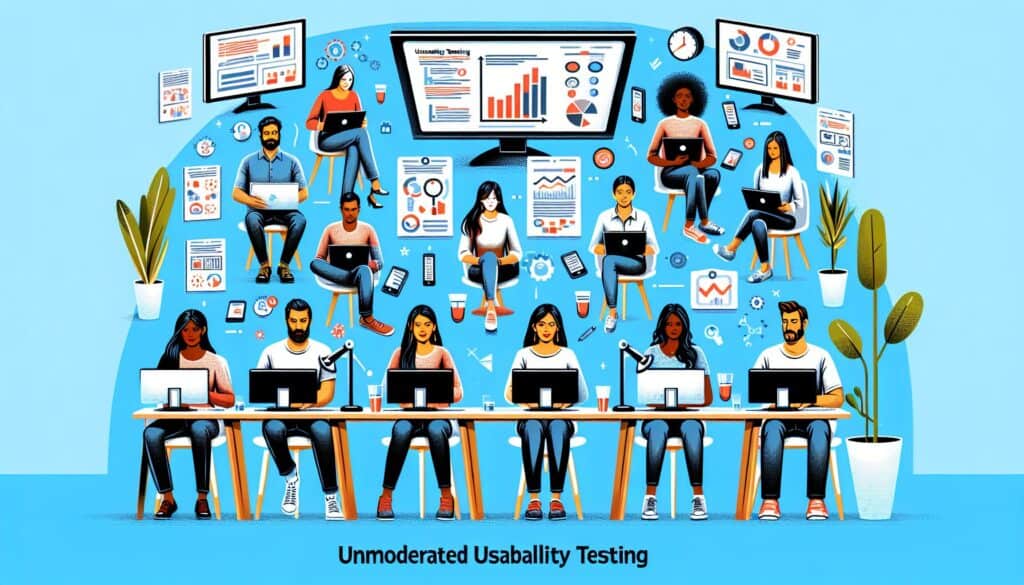A usability evaluation method where participants complete predefined tasks with a product or prototype on their own, without a moderator present, typically using an online testing platform that records their screen, voice (if think-aloud is requested), and clicks.
- 方法: 客户与营销, 经济学, 精益西格玛, 制造业, 项目管理, 质量
无人主持的可用性测试(通常是远程测试)

无人主持的可用性测试(通常是远程测试)
- 设计评估, 设计思维, 人机交互, 可用性, 可用性测试, 用户体验(UX), 用户界面(UI), 用户测试, 以使用者為中心的設計
目标
如何使用
- 参与者通过链接进入测试,按照说明完成任务,他们的互动会被自动记录。他们可能会回答任务前和任务后的问题。然后,研究人员对数据进行审查和分析。
优点
- 招募参与者的成本效益更高,速度更快,收集的样本更多、更多样化;参与者处于自然环境中,可能导致更真实的行为;没有调节偏差。
缺点
- 无法实时探究或提出后续问题;参与者可能会误解任务或遇到技术问题而得不到及时帮助;"大声思考 "数据的质量可能差别很大;对测试环境的控制较少。
类别
- 客户与营销, 产品设计, 质量
最适合:
- 从更多用户那里快速收集定量和定性的可用性数据,尤其是在测试特定任务或验证设计迭代时,无需进行深入探究。
Unmoderated Usability Testing is particularly applicable in the stages of product development where iterative testing and validation are necessary, such as during prototyping or post-design reviews. Industries utilizing this methodology range from software development and e-commerce to mobile application design and user interface engineering, where rapid feedback cycles are common. Participants often include end-users who can be recruited via platforms like UserTesting or Lookback, allowing for a diverse demographic representation. These tests can be initiated by product managers, UX designers, or researchers who set specific tasks targeting certain features or workflows. As users perform tasks in their natural settings, insights captured reflect authentic interactions with the product, facilitating the identification of usability issues that might not emerge in traditional moderated sessions. This method can also employ various tools for automatic video and screen recording, allowing researchers to analyze user behavior in detail, enhancing the understanding of how users engage with specific elements of the design. Furthermore, the ability to receive both qualitative feedback through post-task questions and quantitative metrics can drive informed decision-making in iterative design processes, helping teams prioritize changes that will significantly enhance user experience.
该方法的关键步骤
- Define clear objectives and tasks for the usability test.
- Create a user-friendly test environment accessible via a link.
- Provide participants with straightforward instructions for task completion.
- Automatically record participant interactions during the testing process.
- Include pre-task and post-task questions for additional context.
- Monitor participant behavior indirectly to ensure natural interactions.
- Analyze and interpret the collected data for usability findings.
专业提示
- Utilize task scenarios that reflect real-world contexts to elicit more authentic user behavior and feedback.
- Incorporate qualitative follow-up questions that encourage participants to articulate their thought processes during task completion.
- Implement automated analysis tools for faster data processing, allowing focus on nuanced interpretations of user interactions.
历史背景
1986
(如果日期不详或不相关,例如 "流体力学",则对其显著出现的时间作了四舍五入的估计)。

相关文章
肌肉骨骼不适调查表
多变量测试(MVT)
多元回归分析
动作捕捉系统
MoSCoW 方法
情绪中值测试